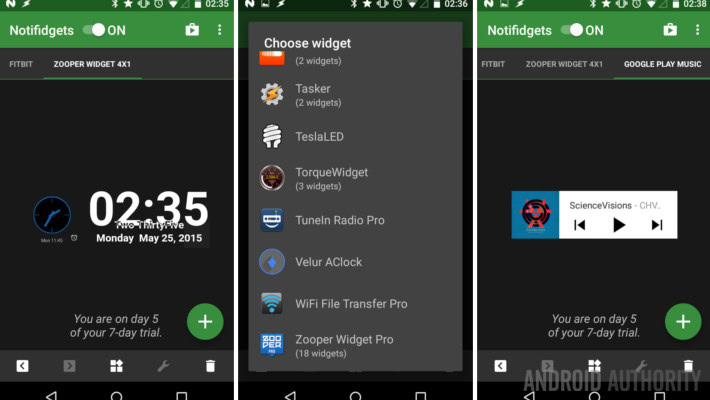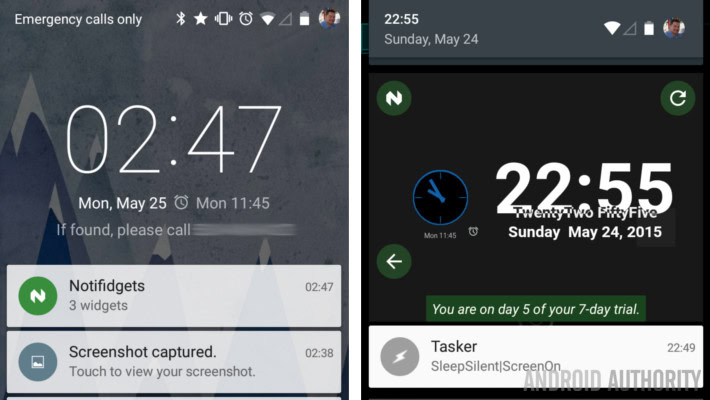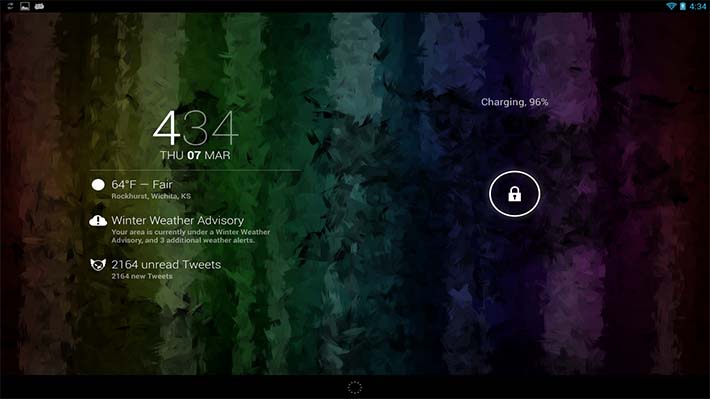Affiliate links on Android Authority may earn us a commission. Learn more.
Lock screen widgets on Android Lollipop - Android customization
Have you had greater success with your spelling after taking control of your auto-correct settings in last week’s Android customization post? I hope so. Now that you are in control of your Android keyboard, let’s take a look at controlling your Android lock screen, or at least utilizing it with widgets.
The idea of putting a widget on your lock screen is not new, it has been around since Android 4.2 natively, and prior using alternate apps. When it was introduced, it was available as a tool that any developer could create or modify their Homescreen widget to show on the lock screen. This was utilized by having the user swipe the default clock to the side and manually add widgets as desired.
Android 5.0 Lollipop changed things up a bit. Gone was the ability to select near any widget for your lock screen, instead swiping to the sides now triggers your phone application and your camera, on stock Android at least. In place, Android introduced a new and complex method and controls for displaying notifications on the lock screen.
Before we begin

Remember, other apps provide similar functionality, like the very similarly named NotifWidget that handles a few more options.
How to put widgets on your Android Lollipop lock screen
The premise is pretty simple here folks, you really cannot put widgets on the lock screen. Since Lollipop has been locked down to just include notifications on the lock screen, the solution has been to put your widgets into notifications.
Notifidgets is simple enough, it is a persistent notification that itself hosts your normal desktop widgets.

Open up Notifidgets and tap the Material Design big green “+” button.
Choose your desired widget.
Special note here that you can select your other customization widgets, like Zooper Widget and Tasker. You recall we’ve talked about both at length before, so you can now put that power right on your lock screen, if you want it.
As you can see, you are able to put multiple widgets into Notifidgets, so go ahead and load up. Just remember that these will be on your lock screen, so anyone that picks up your phone will be able to see and interact with your widgets and the information that they present.
Make sure Notifidgets is turned on with the toggle at the top.
You are done.

The next time your phone locks, you will be able to see your widgets inside of the Notifidgets notification on your lock screen.
If Notifidgets is not showing, make sure that the app has not been closed by a task manager or the like. Also, if you have locked down your lock screen security, be sure to allow all notifications for Notifidgets on your lock screen. If you need assistance managing lock screen security settings, we took a quick look at that a while back as well.
Finally, you will likely find that the Notifidgets notification on your lock screen is in the minimized state, use a two finger pull down action to expand it.
What’s next
Do you recall how I mentioned you are able to place widgets by Zooper Widget in Notifidgets? That was a tongue twister, just as the idea that a deep rooted Zooper Widget with Tasker controls can bring near any functionality and information to your lock screen. Be sure to check out some of our older Zooper Widget and Tasker articles to get an idea of what you might create for your device.

Please keep in mind that Notifidgets is not the only tool out there to take advantage of the new lock screen of Android Lollipop. NotifWidgets and Notifidgets are just the two we’ve been using.
Also, we did not talk at all about the many lock screen alternatives out there, applications that are specifically built to take over the secured entry to your Android device. Many of these apps, especially in the earlier days of Android, were the only way to get custom info on your lock screen. Sadly, many of them were quickly forgotten when Android 4.2 rolled out.
In the end, Google’s vision is to not have you use widgets on your lock screen, the idea and controls for having notifications show prominently is the new approach. We admit that this is a solid technique to make sure that the content you are seeing is new and relevant, but for those of us that like just a little bit more detail, we are happy that there are options out there.
Next week
I hope you liked the idea of Notifidgets, and the ability to place multiple widgets into a single notification on your lock screen. Next week on our Android customization series, we want to tackle this task in a different way with our trusty old what-can’t-it-do application, Tasker.
Do you spend time developing your lock screen, or would you rather just jump into Android and get on with things?